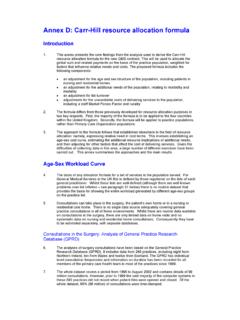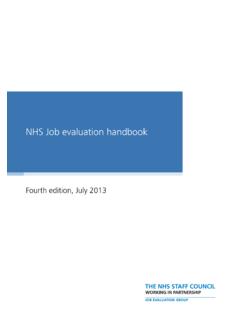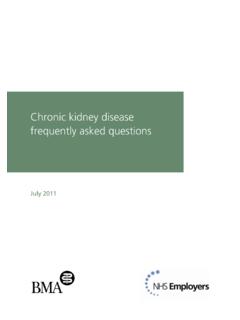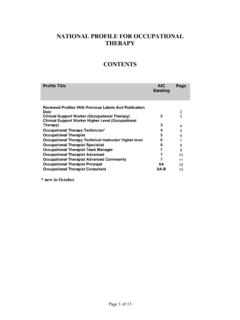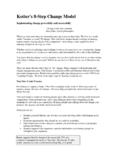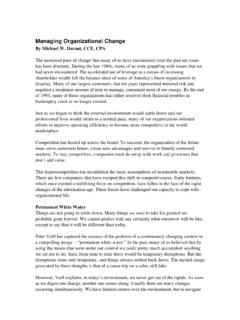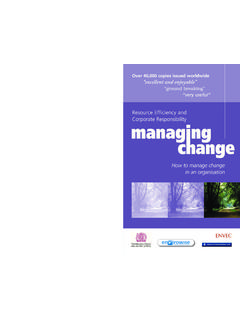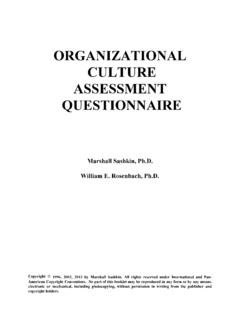Transcription of Managing staff through change - NHS Employers
1 Managing staff through change Introduction change has become a fact of working life. NHS organisations, in particular, have been undergoing rapid change with the introduction of patient choice, the transition to a system of Payment by Results and the move towards practice-based commissioning among recent developments. Much of the literature on organisational change admits that change tends to cost more, take longer, and result in fewer benefits than originally anticipated. Successful change management depends on engaging and properly engaging with the people involved. This chapter aims to assist organisations in Managing change , whether it be merger, de-merger, consolidation of work across an organisation or a restructuring of current services. change management essentials Most aspects of change management are simply an extension of good management practice. The difference is that they are being used in unusual and often demanding circumstances.
2 They require extremely good leadership from the top of the organisation. It is essential that the human dimension to Managing change is recognised right from the outset. Failure to do this results in loss of trust between managers and staff , recruitment and retention problems, poor performance and a failure to learn from the process. It is also important to remember that management perceptions of a change and its effects on staff may not be the same as staff perceptions. Reality may be markedly different to its perception. Communication is king in the process of Managing change . It is the only way to prevent rumours taking precedence over fact. If staff have access to the facts then rumours will not be as likely to become their main source of knowledge. Communication should be frequent, repeated, honest, relevant and most importantly, two-way. It is particularly important for senior managers to be in agreement about the process and to be seen and heard to be in agreement.
3 This includes agreement about the management style to be used across the organisation. The change process and embedding change into the day-to-day running of an organisation will take longer than predicted. It always does. A human resources strategy for Managing staff through the change process should be developed and put in place as soon as decisions have been made on what change is needed and before anything is communicated to staff . Attention should be given to the human and emotional aspects of change . staff will automatically fear change and this fear will be encouraged by rumour, worries about issues such as job security and pensions and concerns over working practices and new management. During a time of change people are particularly attuned to what is being said and done and will base their expectations on what they see and hear. It is extremely important to consider carefully what is said saying only what you mean and meaning what you say.
4 change is not completed when the actual physical change takes place. The organisation and its staff may well take up to two years to adjust and come to terms with it. The senior manager responsible for Managing the change process should maintain that role well beyond the physical change taking place in order to be available for staff and to manage issues that arise. The effects of change on staff health Major change has a short-term negative effect on staff health, no matter what the type of organisation. Research into private an public sector organisations as far back as the 1960s and 1970s indicates that this is the case. In the case of mergers or de-mergers the impact on an individual can be life altering and, in some cases, health threatening. Suitable action taken by senior managers to alleviate the mental and physical impact on staff can ensure that both organisation and staff emerge from the process in at least as good a state as when it started.
5 change such as major reorganisations will inevitably result in one set of staff feeling themselves to be the victims and these will feel the effects of the change to a greater extent than the other staff involved. Managers will need to manage this carefully in order to minimise, as much as possible, the feelings of hostility that are often exacerbated if reorganisation follows an unwanted merger. Research has found that the staff involved still refer to them and us as many as ten months after a reorganisation or merger1. The way in which staff will react to change will depend to a large extent on their seniority, autonomy and potential employability elsewhere. Groups who are likely to be at particular risk are: top managers whose future is insecure but who because of their culture are unwilling or incapable of admitting vulnerability (theirs or others) and hence act in a way that is unhelpful to themselves or to others middle-level managers and professionals having to cope simultaneously with the pressure from above, worry about their own job security, manage the change within their area and try to support staff who work for them people most threatened by redundancy.
6 1 Covin et al (1996) Clarity about the effects of the change on managers and key staff early in the process can help retain staff who will otherwise leave ahead of decisions being made. Strategies for supporting staff All change is difficult for almost everyone affected and on the basis of good practice Employers should aim to: have a clear and explicit rationale for the change that is being attempted communicate that rationale simply, intelligibly and honestly and repeatedly andfor a long time in both the run up to the change and after its implementation communicate to staff groups, trade union representatives, SHAs, PCTs, other local NHS organisations, where these will be affected by the change manage the change process so well, respecting all staff , that the dip in performance that is usual both in the run up to and immediately after change do not happen through multiple channel and two-way communication that concentrates on short-term benefits (6-18 months) plan for and resource the extra workload that the change process will involve for senior managers make an early decision on any top level appointments and clarify whether any jobs are at risk or significantly affected.
7 Effective leadership and good planning should enable the rebuilding of staff morale and performance within about two years. Phase 1: Pre- change discussions Before any change takes place, initial scoping work should be carried out to identify issues such as cultural differences/similarities that might affect the success of the change strategy, benefits sought from the changes to be made and the rationale for the process. Once this has been done there should be a public or organisation-wide announcement of the proposed change . Questions for managers involved in Managing change : think carefully and honestly about why you are instituting the changes and what you expect to deliver through them can you explain the purpose of the changes intelligibly to others? how are you going to support staff through the change and can you put in place the resource(s) to continue this support beyond the end of the process for several months?
8 Key points: set the right tone from the start by ensuring that staff are communicated with as early as possible in the process and that the first communication is done in person and face-to-face by senior management. This may mean a couple of days of very intensive meetings but leaving gaps in the process will encourage rumour and concern. involve the trade union representatives and do not let the change proposals come as a major surprise to them consider who should deliver the message to achieve the greatest impact symbolically and what the message is going to be. The message must be the same to all groups to avoid raising concerns about one group being treated differently from another in a large organisation it may be necessary for a group of senior managers to be delivering the briefing at the same time in different parts of the organisation. tell staff what it is that you do not yet know the answers to and how you intend to go about finding them be honest not all staff will be able to attend so supplement the briefing with a written one for all staff who are not present in person and make sure it goes to them at the same time as the briefings are taking place do not make any promises you or the organisation cannot keep, not even on the spur of the moment, and make sure that any promises that are made are kept tothe letter so as not to create disappointment and mistrust.
9 Phase 2: Implementation This is the time for putting plans in to action, but before you start you need to check whether you: have a strategy for Managing the change have everyone in the senior team signed up and agreed on the reasons for change and manner of implementation have appointed a senior manager to oversee the implementation and be the first point of reference for staff concerns have staff on board and fully involved in the communication process have an HR plan for Managing staff through the process have in place methods for assisting the staff groups and individuals who may suffer anxiety and stress as the change process impacts on them and their work. Also: take time to sharpen up messages for staff and other stakeholders take a long hard look at where there might be potential barriers to achieving your aim, and if there are any assess what measures you can take to deal with them.
10 Helpful ideas: take account of feedback from all sources and where necessary respond by adjusting your key messages organise regular team briefings and put in place a mechanism for information to feed up as well as down ensure that senior management is visible across the organisation use existing communications channels, such as newsletters, to supplement the information flow arrange face-to-face meetings where change is going to affect a particular staff group or work area post Q&As on noticeboards so everyone can read them set up a telephone rumour-scotching helpline. If the change programme involves no redundancies say so and keep on saying so as staff will find it hard to believe. If there is any chance of redundancies arising from the process do not say that there won t be any and then implement them as this will only increase mistrust among staff . If you cannot give assurances about job losses then try to be clear about the timetable for decision-making about posts and the post-filling process.


